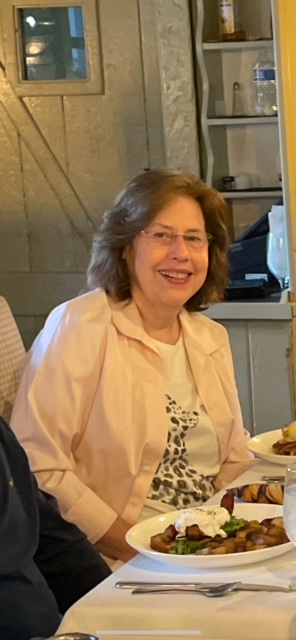Brain-injured patient Denise Grim of Oklahoma recalls her response to a casual remark by Mind-Eye Institute founder and optometrist Deborah Zelinsky, OD. “Dr. Zelinsky mentioned how she wanted to change the world for patients [by advancing the science of optometry]. And I told her, ‘You have already changed the world. You have given people their lives back. You have given them hope.’”
Denise speaks from experience. She traveled to the Mind-Eye Institute in Northbrook, Illinois, after more than 18 months of struggles with the debilitating symptoms of a head injury incurred in a fall at home. “When I arrived, I was nervous, but also excited at the thought of finally getting some help.”
The person who initially told her about the Mind-Eye Institute was none other than her cousin, himself a practicing optometrist in North Carolina. “He had taken his own daughter to Dr. Zelinsky and the Mind-Eye when she had suffered a head injury. My cousin told me what Dr. Zelinsky had done for his daughter. He said, ‘I don’t understand the science, [but it works].’ My cousin’s daughter is back to 100 percent today, “ Denise reports.
Dr. Zelinsky is an international expert in retinal processing. Her groundbreaking studies and clinical work in changing brain function by using light to stimulate the retina has brought symptom relief to literally thousands of patients with head trauma, stroke, and other neurological disorders or with undeveloped visual processing skills.
Retinal cells generate electrical signals from environmental light. These signals propagate through neurons and interact with critical brain structures, affecting not just the visual cortex for eyesight but other, significant regions of the brain as well, like the limbic system and brainstem.
“The right mix of prescriptive eyeglass lenses, filters and prisms affects the spatial and temporal distribution of light on the retina. The intent is to modify the dynamic relationship between the mind’s visual inputs and the body’s internal reactions and responses to both image-forming and non-image forming signals. Mind-Eye glasses achieve this by modifying the angle, intensity, and angle of light passing through the retina,” Dr. Zelinsky indicates.
The implication is that retinal stimulation can intentionally promote changes in a patient’s basic physical, physiological, and even psychological systems involved in metabolism, motor control, posture, mood, circadian rhythms, and decision-making abilities. These “customized changes” to the brain are what oftentimes bring relief to patients experiencing headaches, brain fog, and concentration and attention difficulties due to brain injury or autonomic dysfunctions, genetic mutations, and disease, she explains.
The constant headaches that Denise developed after her fall interfered with her sleep. She also experienced vertigo and increasing light sensitivity to the point where “I became a prisoner in my home. I had to black out the windows. Eventually, even the artificial light inside my home began bothering me,” she notes. Reading, too, became difficult – “I could not remember what I read in the previous paragraph,” her memory declined, and multi-tasking was “simply overwhelming.”
Even worse, Denise avoided socializing with friends and other family members because of problems engaging in conversation. “I could not think of the right words to say, or I would say the wrong word and be embarrassed by it.”
What most amazed Denise at the Mind-Eye Institute’s clinical center was the comprehensiveness and uniqueness of testing during her first visit. Her reaction to the Z-Bell Test℠ was “You got to be kidding me; no way.”
Dr. Zelinsky developed the now globally recognized Z-Bell Test℠ as a simple, but revolutionary, method of evaluating a patient’s overall integration of retinal processing with awareness of auditory space – basically, the stability of the eye-ear connection. During the test, a patient reaches out, with eyes closed, and tries touching a ringing bell. If the patient cannot do so, a Mind-Eye optometrist determines the optimal combination of lenses to place in front of the patient’s closed eyelids allowing the patient to find the bell immediately without conscious effort. Light still passes through the eyelids and activates parts of the brain not used for eyesight. With eyes closed, patients must visualize surrounding space in order to locate the bell. Auditory localization and visual localization must match to lessen overall effort and sensory confusion.
“Initially, I was way off. I tried to memorize where the bell was positioned during the test, but, when I closed my eyes, I still could not touch it,” Denise laughs, “at least not until Dr. Zelinsky put the most appropriate lenses over my eyes. Dr. Zelinsky explained that my head injury had caused my brain to become confused, which is why I was so far off from touching the bell.”
“Eye-ear connection is the concept underlying clinical work at the Mind-Eye Institute,” says Dr. Zelinsky. “Our sensory systems are like musicians in an orchestra. Each musician may be highly skilled in a specific instrument, but without a conductor synchronizing what they are playing, the result is simply noise – not music. Mind-Eye brain glasses are intended to re-integrate the senses and affect how the brain reacts to information about the environment.”
Since receiving her highly individualized, therapeutic glasses, Denise has enjoyed a gradual lessening of symptoms. “My head and neck pain have decreased, allowing me to sleep much better. I also have noted improvement in light sensitivity.”
She adds, “Now, I tell everyone if you have such and such problem, go to the Mind-Eye Institute. Dr. Zelinsky gave me my life back, and I am so grateful.”
Although Denise Grim reports progressive symptom relief, her experience is not always the norm, nor is it guaranteed for every patient. Check out the Mind-Eye Institute at www.mindeye.com for additional information.

Success Stories, Traumatic Brain Injury
Mind-Eye Has ‘Changed the World’ One Patient at a Time
About Z-Bell Test℠, Denise Grim Says, ‘You Got to Be Kidding Me’
